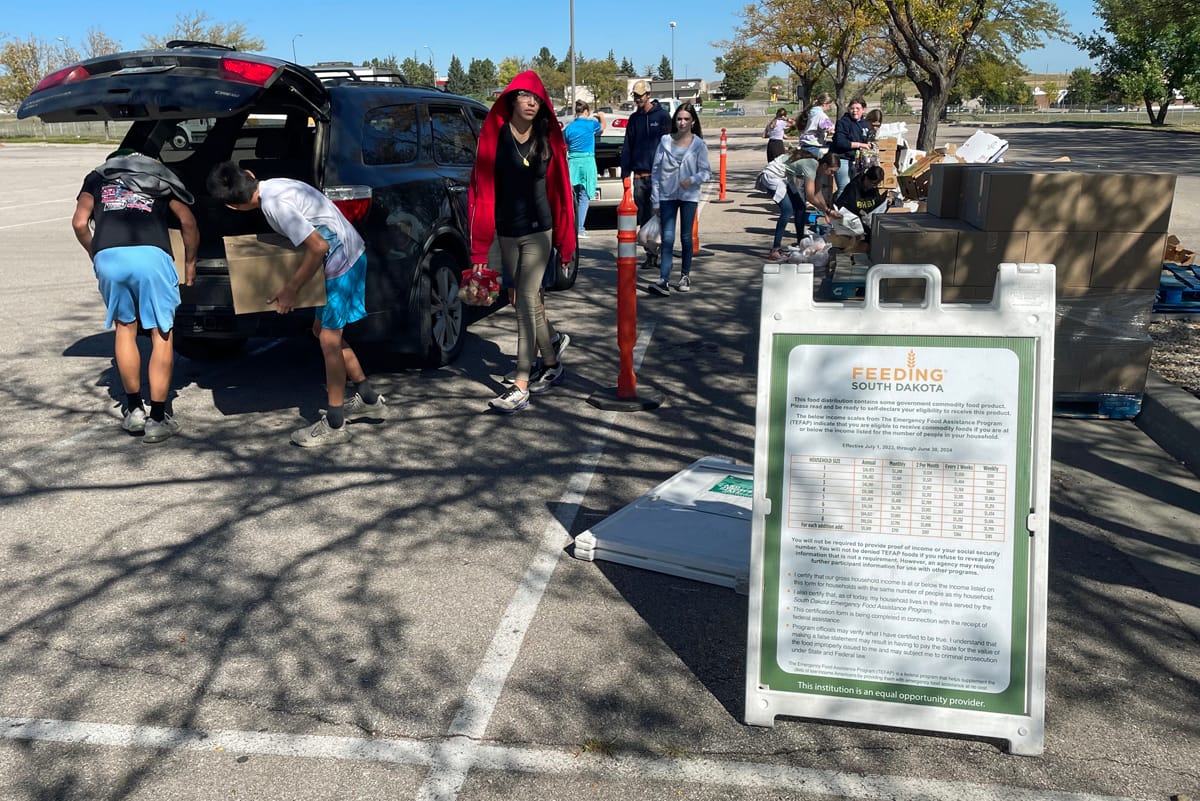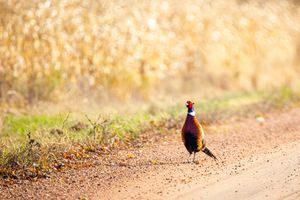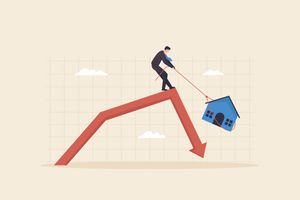South Dakotans who rely on food stamps missed out on $100 million for groceries because the state declared an end to the COVID-19 emergency while federal funding was still available, according to an analysis prepared by the state Legislative Research Council and obtained by News Watch.
Gov. Kristi Noem decided in July 2021 that South Dakota had recovered enough from the pandemic and ended the formal emergency far earlier than most other states. That prevented the state from taking the estimated $103 million in additional emergency funding through the U.S. Department of Agriculture’s Supplemental Nutrition Assistance Program (SNAP) available until March 2023.
The estimate is likely low because emergency allotment totals rose as more people qualified for SNAP benefits in early 2021, the LRC analysis said.
Thirty-two other states took the funding until the program ended. South Dakota was one of the first states to end its state of emergency and stop taking the money for food to low-income residents, people with disabilities and families with children.

According to amounts from the final month South Dakota took the emergency funding, about 34,600 households lost out on an average of $150 per month over those 19 months.
Critics of Noem’s decision — including a South Dakota lawmaker, grocer and food stamp recipient — said it prevented low-income families and individuals from buying more food during the lingering months of the pandemic. It also denied grocery retailers millions of dollars in revenue, they said.
But Noem’s communications director, Ian Fury, said the governor concluded the state economy had “fully recovered” from the pandemic and that a state of emergency was no longer needed.
The unemployment rate had fallen to pre-pandemic levels, the tourism industry had rebounded and “our COVID peak was long in the rearview mirror,” he wrote in an email to News Watch.
“This spending was not necessary to combat the COVID-19 pandemic,” Fury wrote.
‘Some of us couldn’t recover’
That explanation, however, doesn’t sit well with Michelle Alexander, 63, of Rapid City, who lives on a fixed income that includes monthly SNAP benefits.
Alexander said she and others she knows suffered from pandemic-related job and financial strife that remain to this day and that the added SNAP benefits were highly needed well after July 2021.
“People lost their jobs and fell behind, and some of us just couldn’t recover,” Alexander said recently as she waited in a line of cars at a Feeding South Dakota monthly food distribution event in Rapid City.
Feeding South Dakota, a leading state food charity, estimates that about 25,000 South Dakota children currently don’t get enough to eat. The organization saw a 20% increase in families visiting its mobile distribution sites from June 2022 to July 2023, roughly the time period when many pandemic-era assistance programs came to an end and inflation began to rise.
“The SNAP program is the most effective anti-hunger program in the United States,” group spokeswoman Stacey Andernacht wrote to News Watch in an email. “It helps people buy the food they need to lead healthy lives while also stimulating economic activity.”
Small boost, big benefit
Alexander said she suffers from joint problems in her knees that made it impossible to work her regular job in retail. She needs surgery but cannot afford a $625 test for a possible allergy to metals that has so far prevented her from getting knee surgery.
Alexander said she received about a $40-a-month bump in her monthly SNAP benefit during the first year of the COVID-19 pandemic, bringing her food stamp allowance to $281 a month. When the emergency allotments ended in August 2021, her monthly benefit fell to about $240, she said.
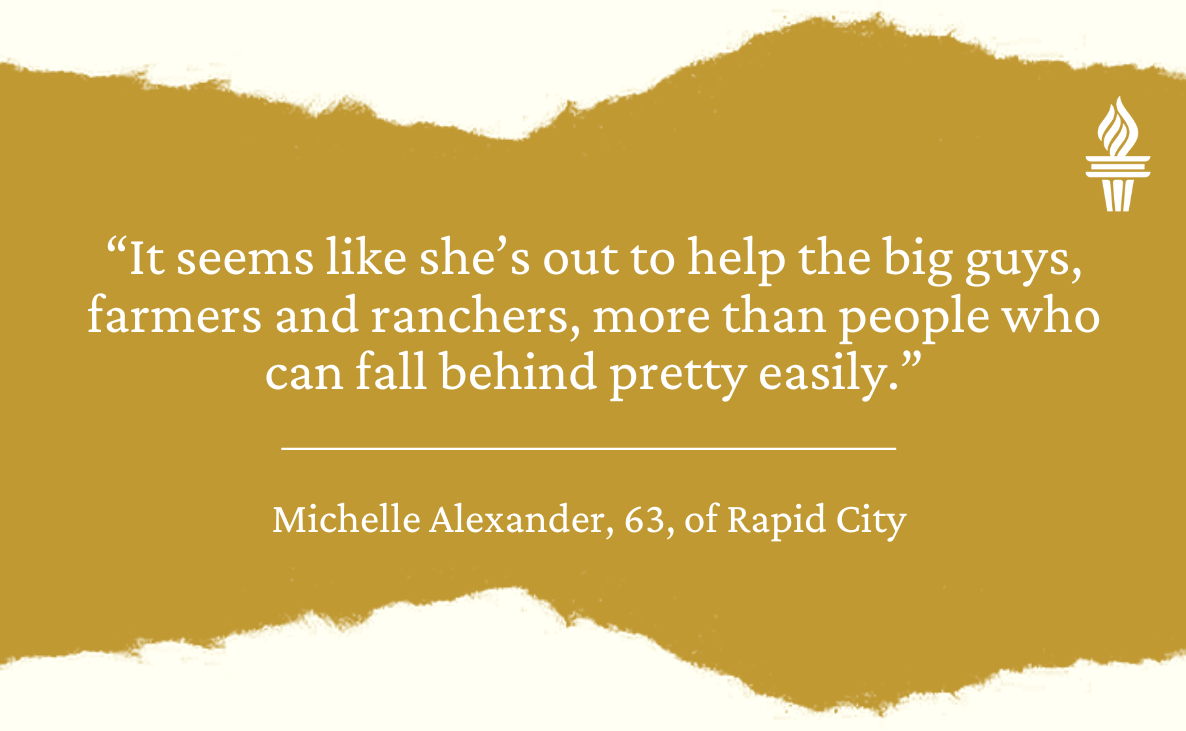
“That extra $40 could buy me a couple 5-pound chubs of ground beef to survive on,” she said.
Alexander was shocked to learn the state turned down additional food stamp funding, especially given the hard times people endured over the past three years. The rising cost of food, housing and other monthly expenses have added to the financial burdens of people on fixed incomes, she said.
“Maybe she (Noem) had other things to do than help people who are having a hard time struggling with food money. It seems like she’s out to help the big guys, farmers and ranchers, more than people who can fall behind pretty easily.”
Noem’s office defends rejection: ‘More … is often not a good thing’
Fury denied a News Watch request to interview Noem but said in his email to News Watch that “federal funding often comes with strings attached, and more of it is often not a good thing.”
News Watch has previously reported on how South Dakota returned $80 million of federal pandemic rental assistance and didn’t apply for $7.5 million in 2022 and 2023 for low-income children during summer.
Fury also pointed out that Noem was the only governor in the country to reject an offer from the Trump Administration for extended unemployment benefits for state residents in August 2020.
“Governor Noem absolutely believes that the federal government’s wasteful spending, much of it at the behest of President Biden, is the single largest cause of the inflation crisis that our nation finds itself in,” Fury wrote in his email.
“The federal government bailed out other states for their unconstitutional decisions, and the American people are paying the price every day at the grocery store, at the gas pump and with every purchase that they make.”
State gets billions from Uncle Sam for other programs
But the SNAP money represents a fraction of the federal largesse sent to South Dakota before, during and since the COVID-19 pandemic.
News Watch earlier reported that from March 2020 to January 2023, the state government received about $4.2 billion in pandemic emergency funding.
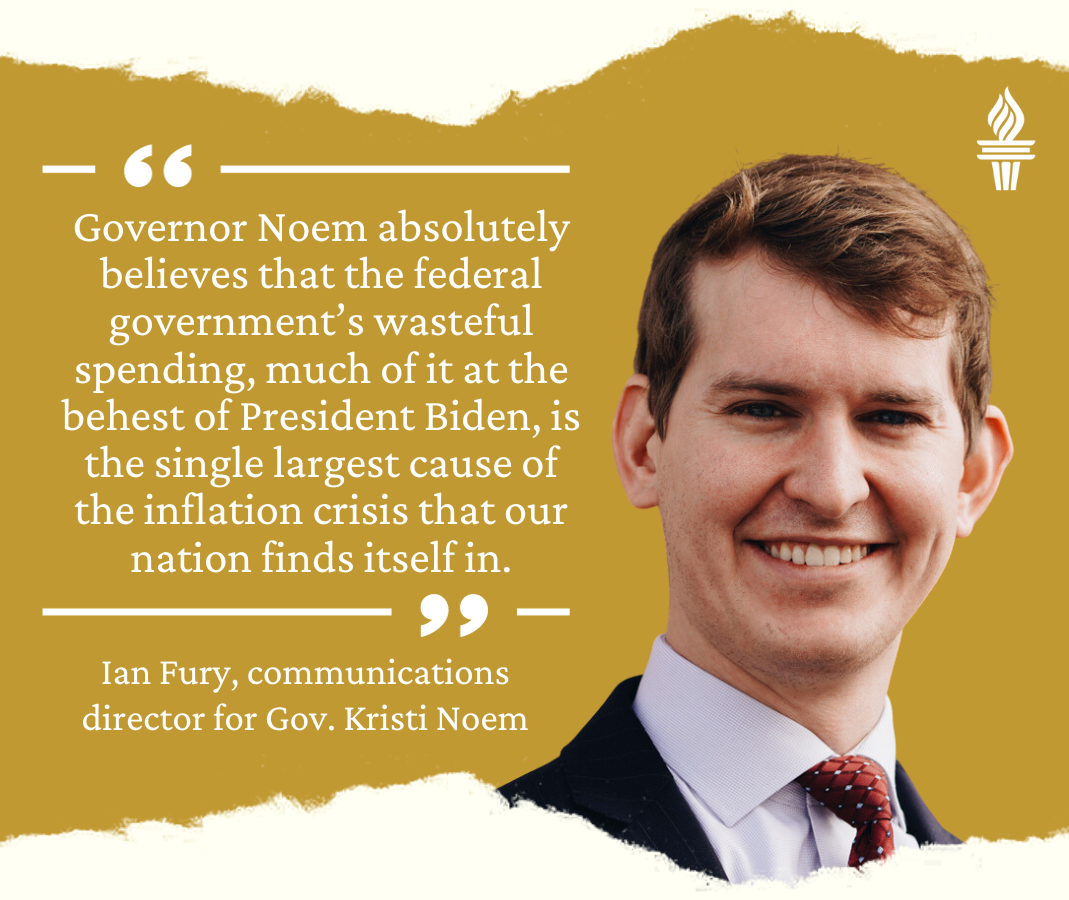
Another $9.6 billion in federal aid was provided to local governments, health care facilities, educational institutions, businesses and individuals in the state.
Furthermore, South Dakota took in $121.8 billion in federal funding from fiscal years 2008-2022, receiving $9.3 billion over the past 12 months alone, according to USAspending.gov.
The top federal funding sources to South Dakota are the Social Security Administration, followed by the U.S. departments of Health, Agriculture, Veterans Affairs and Transportation.
State took in $60 million in added food benefits
Starting in April 2020, the USDA allowed states to apply for emergency increases in SNAP allotments as part of the Families First Coronavirus Response Act passed by Congress. SNAP is federally funded but is administered by social service agencies within each state.
Overall, the emergency allotments taken through July 2021 totaled $60.4 million. In the first month of the program, the state received $3.5 million in additional benefits for roughly 23,000 households, but those figures rose in the final month to $5.4 million for about 34,600 households.
Records from the South Dakota Department of Social Services show that before the pandemic, in January 2020, about 37,000 households accounting for 78,000 people received $9.9 million in SNAP benefits, an average of $266 per household. Roughly 38,000 of those recipients were children under 18.
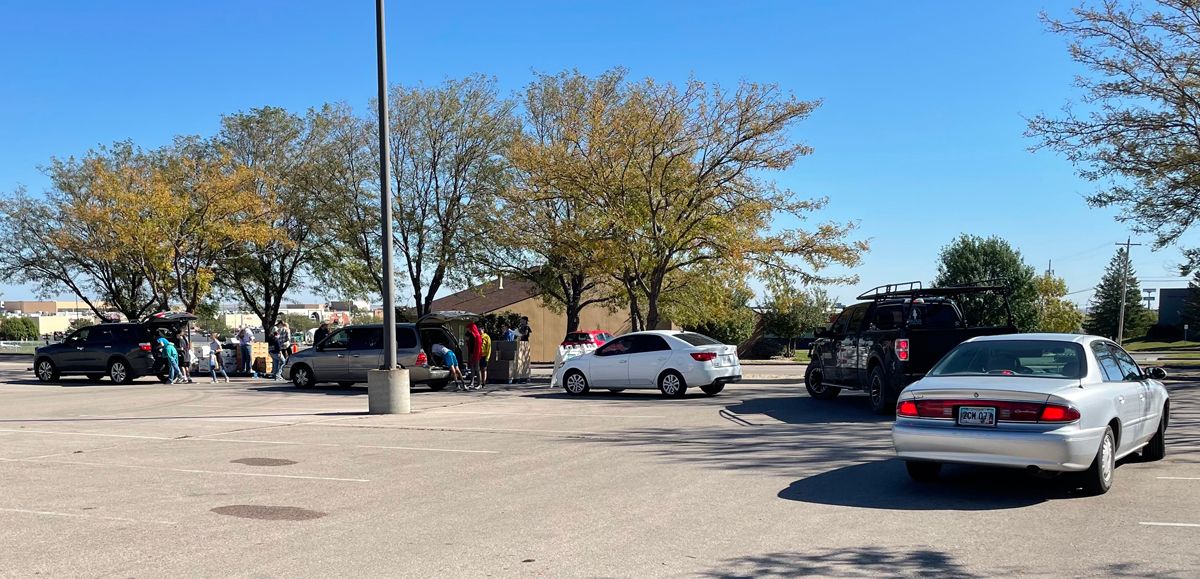
About 35,000 SD households benefited from added SNAP
In July 2021, when South Dakota ended its emergency funding, about 35,000 households received $11.4 million in monthly SNAP benefits, plus the additional $5.4 million in emergency funding.
The additional funds pushed the average monthly SNAP payment from $333 to $498 per household, according to state and federal records. About half of the SNAP recipients that month were children.
In fiscal year 2022, about 47 million U.S. recipients of SNAP benefits received about $80 billion in regular benefits topped off by another $40 billion in emergency allotments, according to the USDA.
When availability of emergency allotments ended in March 2023, 32 states were still accepting the money, USDA records show.
Research is ongoing into the outcomes of the emergency SNAP benefits as well as for a new assessment method that generally increased SNAP benefits in 2021.
An August 2022 research article by the Urban Institute noted, however, that the emergency SNAP benefits kept 4.2 million Americans out of poverty in 2021 and reduced child poverty by 14% in states that accepted the emergency payments.
Rejection of federal funding puts strain on the state’s charities
State Sen. Reynold Nesiba, D-Sioux Falls, said Noem’s decision to reject the federal SNAP funds removed a small but critical revenue stream to low-income families during tough times caused by COVID and inflation.
The SNAP program is part of the congressional Farm Bill and is run by the USDA because it helps people but also supports the agriculture and grocery industries, he said.
“It’s in the Farm Bill for a reason,” said Nesiba, an economics professor at Augustana University who serves on the Senate Commerce and Energy Committee.
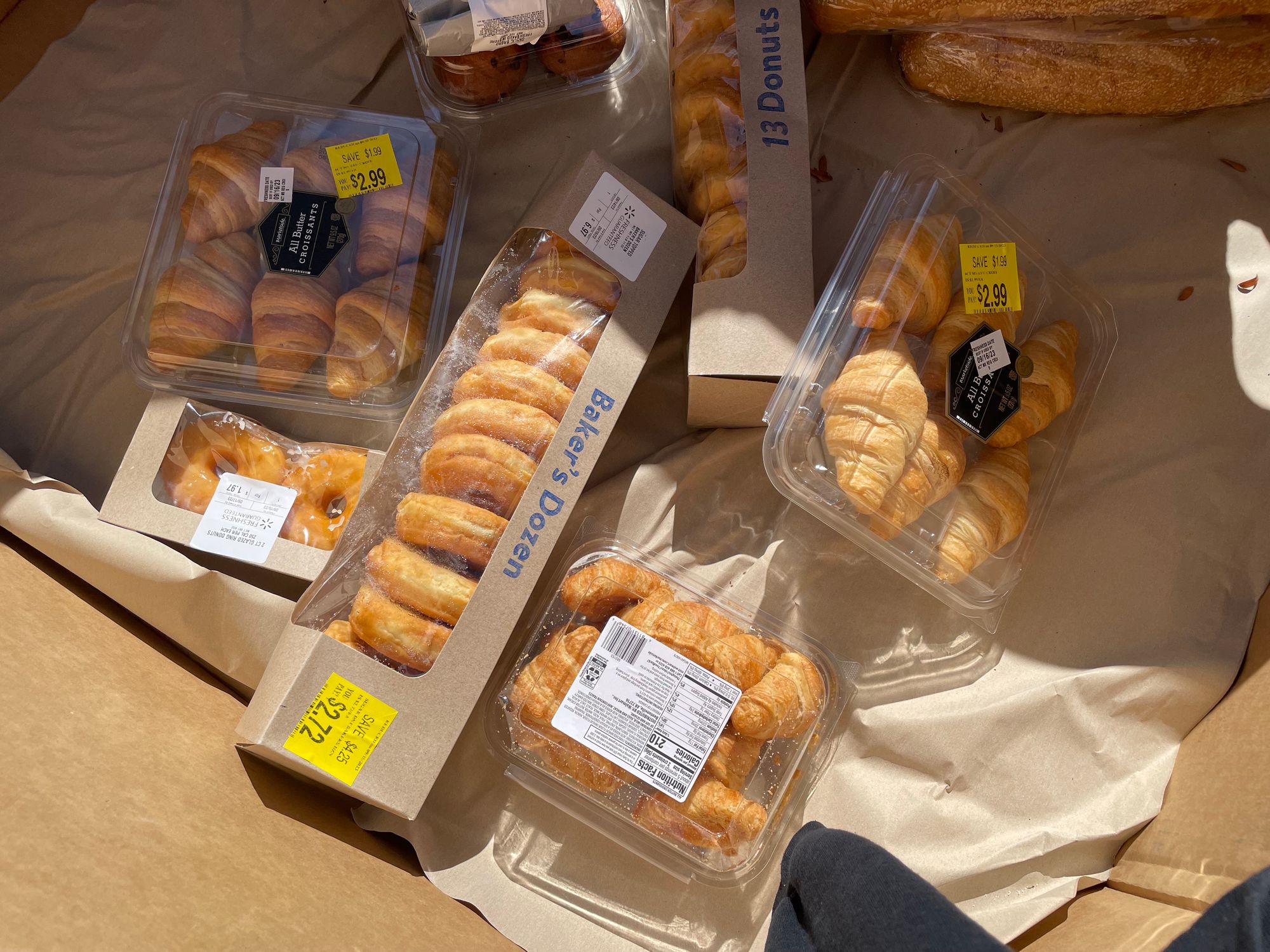
“It’s always been a program about making sure families have access to food but also as a benefit to those grocery stores where people shop and to maintain stable food prices for our agricultural producers.”
Saying no to the federal SNAP funds also put a strain on the state’s charities that provide food to families, he said. Donors and volunteers who support those groups had to chip in more.
“It’s also a real problem for those of us who care about hungry people,” Nesiba said. “That would have been an extra $100 million dollars that either families or nonprofits or people who donate will have to step up with to meet that need.”
Nesiba said he’s unsure why Noem decided not to accept the additional federal funds.
“I suspect that her logic was that if there’s less benefits it will serve as an impetus for people to go to work. But driving people to work through hunger is an idea we should have given up hundreds of years ago,” he said.
Out of touch with state needs?
Nesiba said he wasn’t surprised the governor turned down the additional SNAP benefit funding.
He theorized that rejecting the additional SNAP benefits and the other low-income federal housing and food funding might not have been a deliberate political decision by Noem but rather came as a consequence of her frequent out-of-state travel.
Those moves are indicators that Noem is out of touch with the needs of South Dakotans living on the margins, Nesiba said.
“I think partly the governor is not spending 50 hours a week being governor because she is distracted and focused on lifting her national profile,” Nesiba said. “She’s not giving as much attention or having as many conversations with people across the state to learn how these various programs would affect people in South Dakota. And I wish she was more focused on that.”
COVID infection and fatality data also indicate that the pandemic was still causing health issues in July 2021.
According to the Coronavirus Research Center at Johns Hopkins University, South Dakota saw its peak death count from COVID in late November 2020 (25 weekly deaths, 1,082 cases) and a peak in active cases in late January 2022 (seven weekly deaths, 2,605 cases).
Overall, as of March 2023, the university said South Dakota had reported 279,000 COVID cases and 3,190 deaths.
Newell grocer who would have benefited is OK with early end
Howard “Howdy” Hobernicht has spent 50 years in the grocery business and has owned the small Newmart Grocery in downtown Newell since 1999.
Hobernicht, 70, said his store brings in a steady revenue stream from customers with SNAP benefits, and he was aware of the additional purchasing power those customers brought during the first year or so of the pandemic.
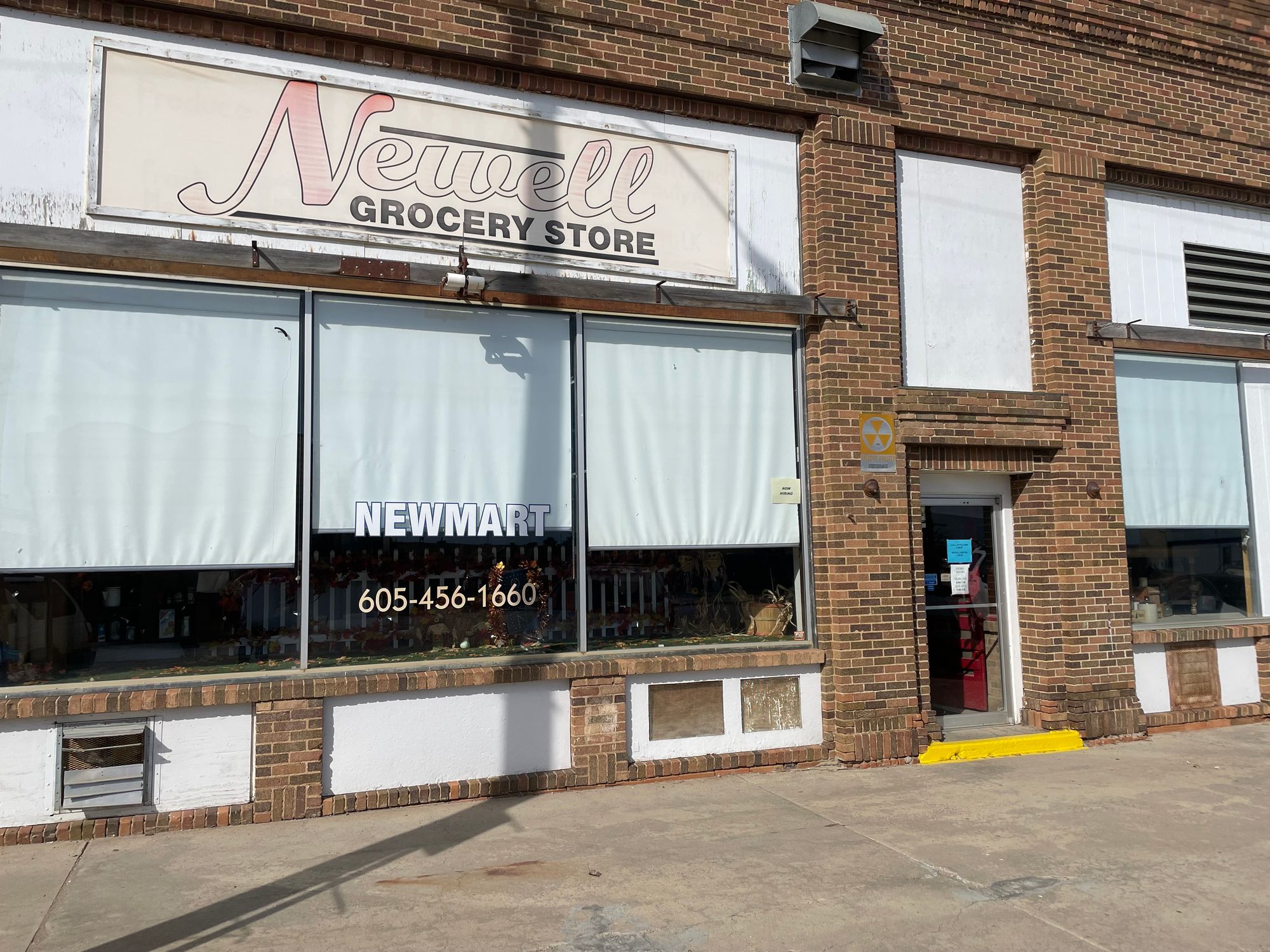
Hobernicht said he supports SNAP as a way to help people who need it, and he was fine with the additional money provided during 2020 and part of 2021. His store needed the extra revenue to pay for inventory and hard-to-find equipment during pandemic supply chain challenges. He also is trying to recoup a significant loss of revenue caused by the opening of a local Dollar General store.
However, Hobernicht supports Noem’s decision to stop taking the emergency payments before the federal program ended.
“On the surface, it seems bad that we didn’t take it, but I think there’s plenty of resources available without it,” Hobernicht said. “I don’t want people to become dependent on it.”
Store owner sees high need in community
Annie Orth, the owner and manager of Merkel’s Foods, a third-generation family-run grocery store in Mobridge, is more troubled by Noem’s decision.
Orth said her business relies in large part on customers who use food stamps, including locals and residents from the nearby Standing Rock Indian Reservation.
Orth said the emergency boost in SNAP benefits helped both her store and low-income families make it through financial hard times during the pandemic. Aside from some initial logistical challenges in ordering and inventory control, the additional SNAP benefits were a major benefit to Merkel’s and the regional economy, Orth said.

“We definitely benefited from that during the pandemic,” she said. “We felt a stronger sense of purpose in our community, where we were no longer just a business trying to make money, we were a business providing a big service to our population.”
‘Maybe that pride took us too far’
Orth realized that additional COVID SNAP benefits had ceased in 2021, but she was surprised to learn that South Dakota ended its involvement early and turned down millions in available benefits for low-income families.
“That’s very foolish because it will never not be needed,” she said. “Whether it was for the pandemic or right now, $300 of groceries is not the same as it was five years ago.”
Orth said it is possible Noem was so proud of the state’s hands-off approach to the pandemic that she refused the additional funding out of pride. Orth is also aware that the federal free meal program for all school students ended in 2022, and that the state turned down the federal summer meal money for low-income students.
“We were super proud of ourselves during the pandemic, and maybe she (Noem) was too proud to accept help,” Orth said. “Maybe that pride took us too far and we didn’t take the available benefits.”
The loss of the added SNAP benefits coupled with high prices due to inflation and other increased costs have made it hard for many families to afford to buy adequate food, even well after the height of the pandemic has passed, Orth said.
“It doesn’t make sense because if there’s money available, you take it. You help the community and you help the state,” she said. “I don’t know that they (state government leaders) get to see how things are in small communities or on reservations. The benefits create economic growth for the whole community, so why not?”

